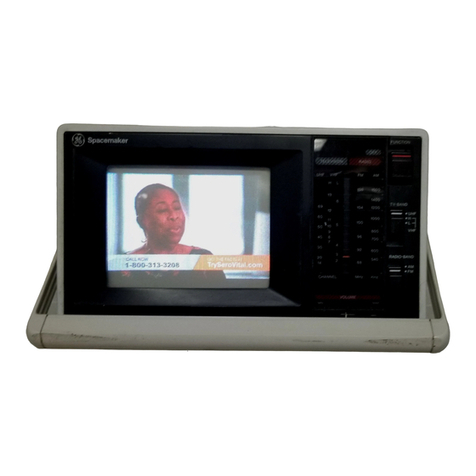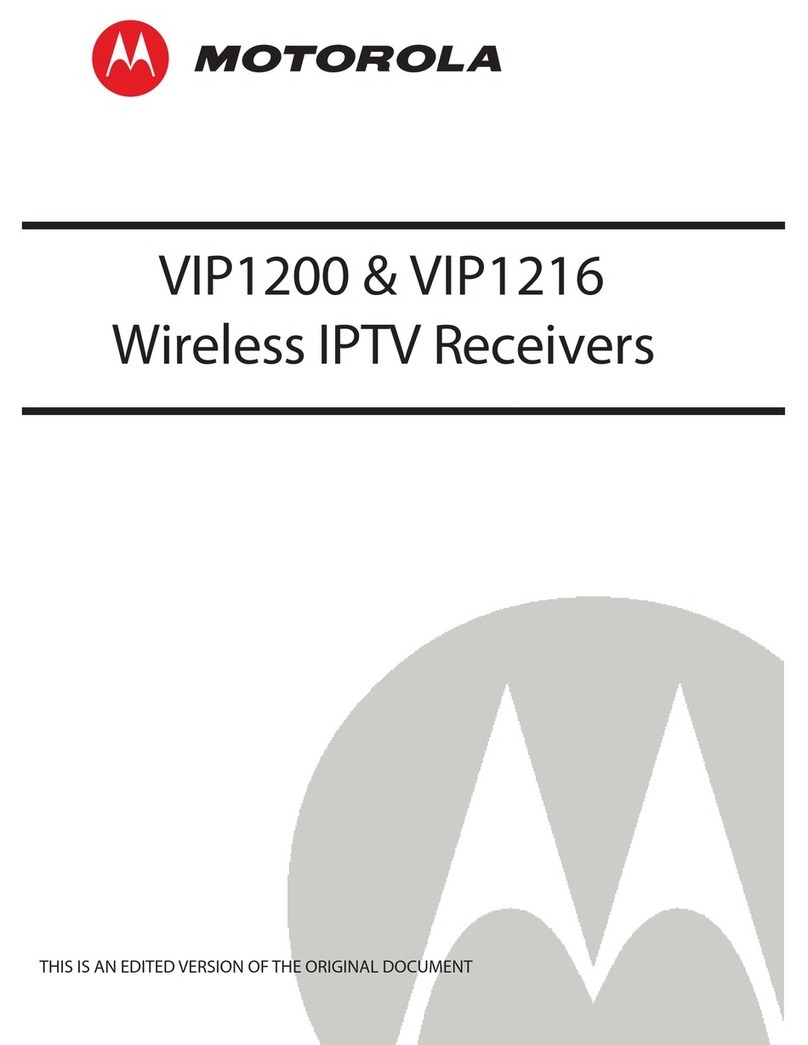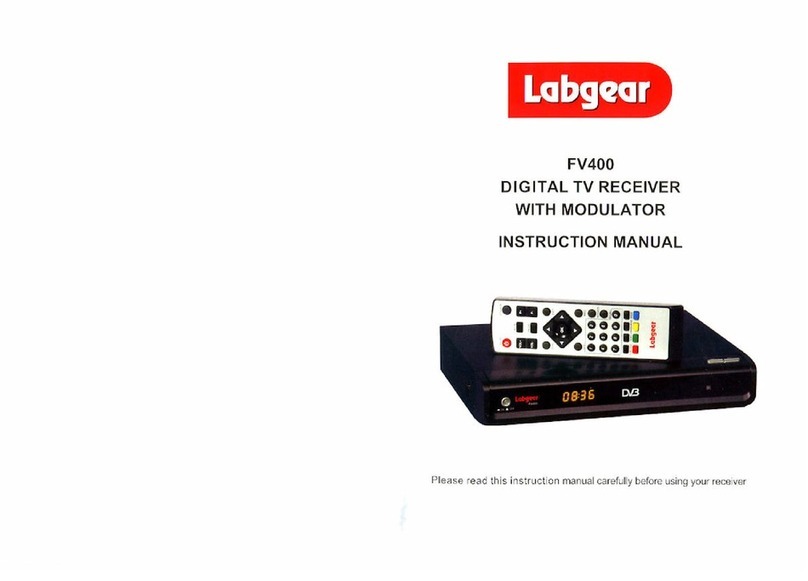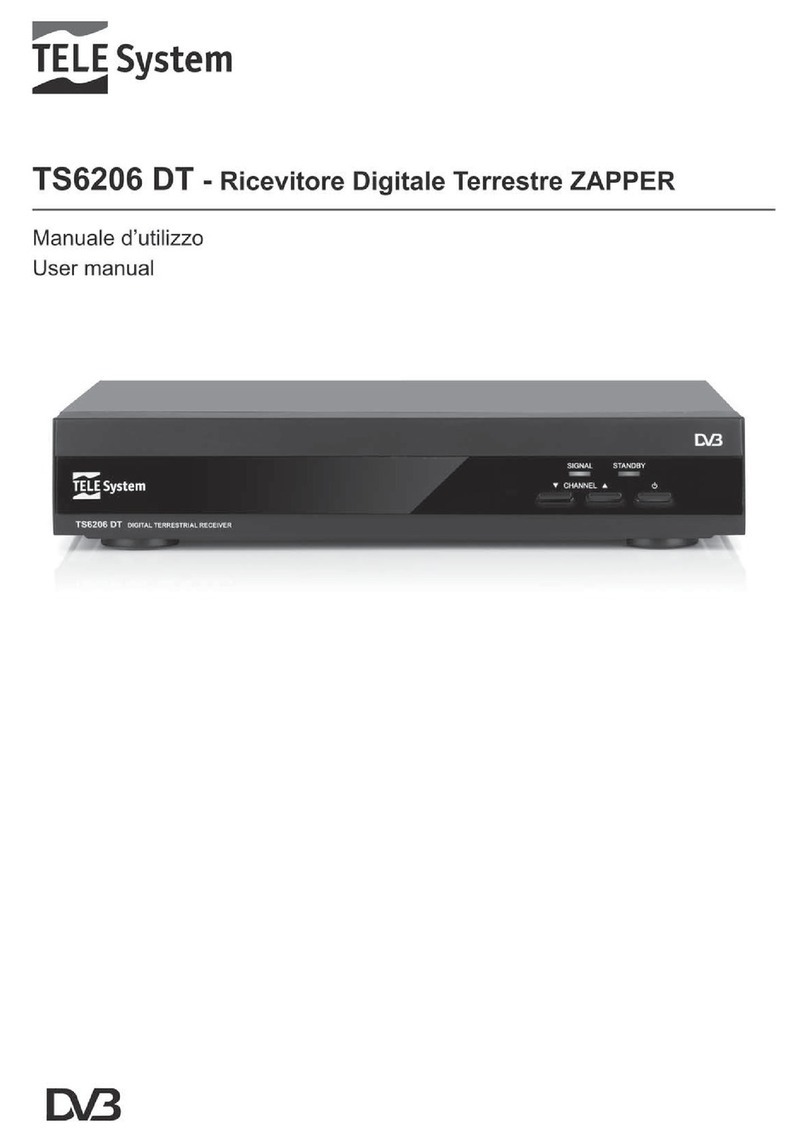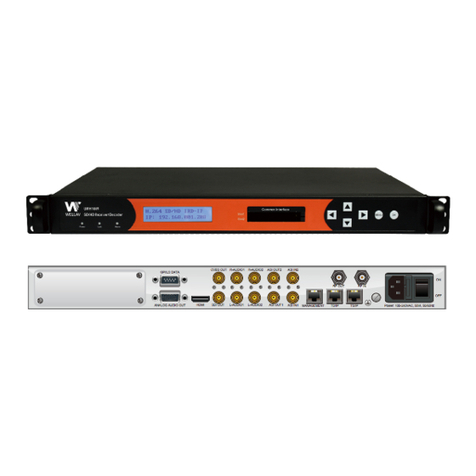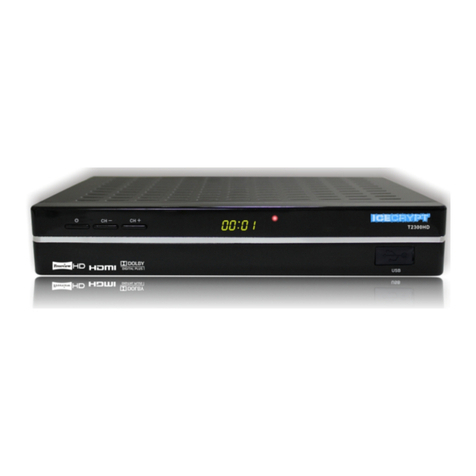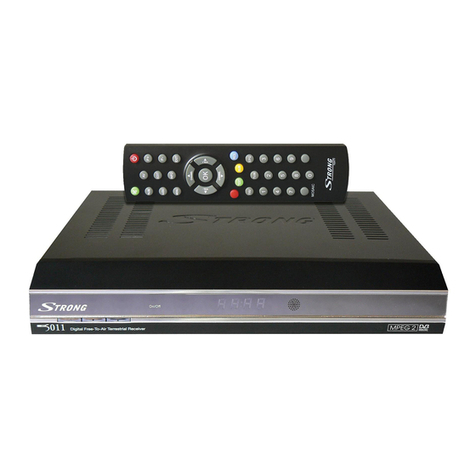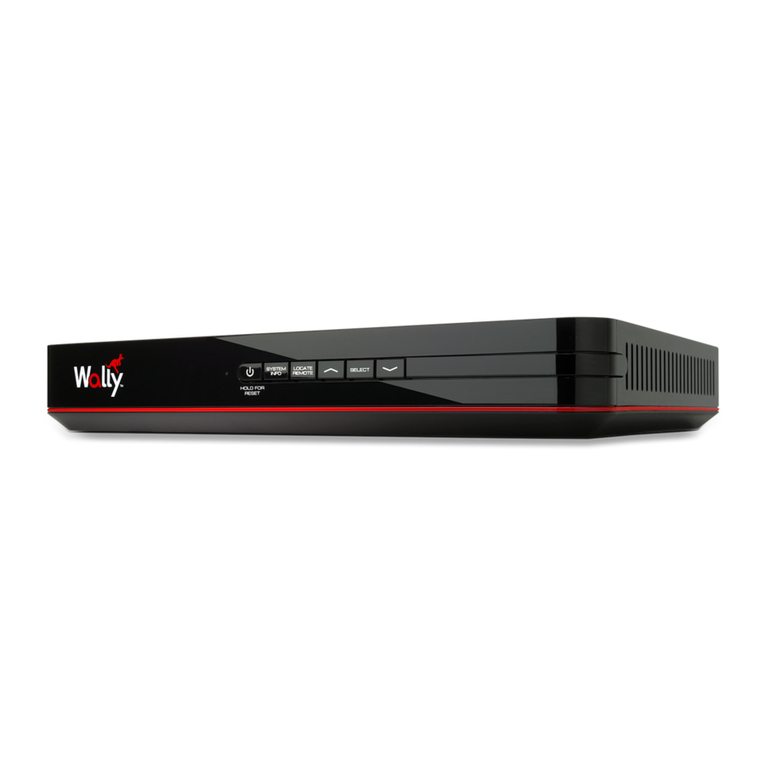Orion DTV2784 User manual

SERVICE MANUAL
DTV2784
S/M CODE NO. M3W4062ASM
DATE OF ISSUE 02/2006
COLOR TELEVISION RECEIVER
ORIGINAL
VERSION (A)
All the specifications and features are subject to change without notice.

IMPORTANT SERVICE SAFETY INFORMATION
Operating the receiver outside of its cabinet or with its
back removed involves a shock hazard. Work on
these models should only be performed by those who
are thoroughly familiar with precautions necessary
when working on high voltage equipment.
Exercise care when servicing this chassis with power
applied. Many B plus and high voltage RF terminals are
exposed which, if carelessly contacted, can cause
serious shock or result in damage to the chassis.
Maintain interconnecting ground lead connections
between chassis, escutcheon, picture tube dag and
tuner cluster when operating the chassis.
These receivers have a "polarized" AC line cord. The AC
plug is designed to fit into standard AC outlets in one
direction only. The wide blade connects to the "ground
side" and the narrow blade connects to the "hot side" of
the AC line. This assures that the TV receiver is properly
grounded to the house wiring. If an extension cord must
be used, make sure it is of the "polarized" type.
Since the chassis of this receiver is connected to one
side of the AC supply during operation, service should
not be attempted by anyone not familiar with the
precautions necessary when working on these types
of equipment.
When it is necessary to make measurements or tests with
AC power applied to the receiver chassis, an Isolation
Transformer must be used as a safety precaution and to
prevent possible damage to transistors. The Isolation
Transformer should be connected between the TV line
cord plug and the AC power outlet.
When removing springs or spring mounted parts from the
tuner, tuner cluster or chassis, shatterproof goggles must
be worn. Keep others without shatterproof goggles away.
Before returning the receiver to the user, perform the
following safety checks:
1.
2.
3.
Inspect all lead dress to make certain that leads are
not pinched or that hardware is not lodged between
the chassis and other metal parts in the receiver.
Replace all protective devices such as nonmetallic
control knobs, insulating fishpapers, cabinet backs,
adjustment and compartment covers or shields,
isolation resistor-capacitor networks, mechanical
insulators, etc.
To be sure that no shock hazard exists, a check for
the presence of leakage current should be made at
each exposed metal part having a return path to the
chassis (antenna, cabinet metal, screw heads,
knobs and/or shafts, escutcheon, etc.) in the
following manner.
Plug the AC line cord directly into a 120V AC receptacle.
(Do not use an Isolation Transformer during these
checks.) All checks must be repeated with the AC line
cord plug connection reversed. (If necessary, a
nonpolarized adapter plug must be used only for the
purpose of completing these checks.)
If available, measure current using an accurate leakage
current tester. Any reading of 0.35mA or more is
excessive and indicates a potential shock hazard which
must be corrected before returning the receiver to the
owner.
If a reliable leakage current tester is not available, this
alternate method of measurement should be used.
Using two clip leads, connect a 1500 ohm, 10 watt
resistor paralleled by a 0.15µF capacitor in series with
a known earth ground, such as a water pipe or conduit
and the metal part to be checked. Use a VTVM or
VOM with 1000 ohms per volt, or higher, sensitivity to
measure this AC voltage drop across the resistor. Any
reading of 0.35 volt RMS or more is excessive and
indicates a potential shock hazard which must be
corrected before returning the receiver to the owner.
TO EXPOSED
METAL PARTS TO KNOWN
EARTH GROUND
AC SCALE
VT VM
0.15K OHMS
10W
15µ F
TEST PROBE
A1-1

PCBs (manufactured) using lead free solder will have a PbF printing on the PCB.
(Please refer to figures.)
Caution:
Pb free solder has a higher melting point than standard solder;
Typically the melting point is 86°F~104°F(30°C~40°C) higher.
Please use a soldering iron with temperature control and adjust it to 650°F ± 20°F (350°C ± 10°C).
In case of using high temperature soldering iron, please be careful not to heat too long.
Pb free solder will tend to splash when heated too high (about 1100°F/ 600°C).
All products with the printed circuit board with PbF printing must be serviced with lead free solder.
When soldering or unsoldering, completely remove all of the solder from the pins or solder area,
and be sure to heat the soldering points with the lead free solder until it melts sufficiently.
Distinction of PbF PCB:
Recommendations
Recommended lead free solder composition is Sn-3.0Ag-0.5Cu.
ABOUT LEAD FREE SOLDER (PbF)
•
•
•
A1-2

A1-1
A1-2
A2-1
A3-1~A3-4
B1-1
B2-1, B2-2
C-1
C-1, C-2
C-3
D-1~D-6
E-1~E-5
F-1, F-2
G-1
H-1, H-2
H-3, H-4
I-1~I-4
I-5
J-1, J-2
J-3, J-4
J-5, J-6
J-7, J-8
J-9, J-10
J-11, J-12
J-13, J-14
J-15, J-16
J-17, J-18
J-19, J-20
J-21, J-22
J-23, J-24
J-25, J-26
K-1, K-2
L-1
M1-1
M1-1
M2-1~M2-7
TABLE OF CONTENTS
A2-1
IMPORTANT SERVICE SAFETY INFORMATION ...........................................................................................
ABOUT LEAD FREE SOLDER (PbF)...............................................................................................................
TABLE OF CONENTS ......................................................................................................................................
GENERAL SPECIFICATIONS ..........................................................................................................................
DISASSEMBLY INSTRUCTIONS
1. REMOVAL OF ANODE CAP...................................................................................................................
2. REMOVAL AND INSTALLATION OF FLAT PACKAGE IC ....................................................................
SERVICE MODE LIST.......................................................................................................................................
WHEN REPLACING EEPROM (MEMORY) IC .................................................................................................
RE-WRITE FOR DIGITAL SOFT FIRMWARE ...................................................................................................
ELECTRICAL ADJUSTMENTS .........................................................................................................................
TROUBLESHOOTING GUIDE ...........................................................................................................................
IC DESCRIPION ................................................................................................................................................
SEMICONDUCTOR BASE CONNECTIONS .....................................................................................................
BLOCK DIAGRAM
MICON/CHROMA ..........................................................................................................................................
SD DIGITAL MODULE ...................................................................................................................................
PRINTED CIRCUIT BOARDS
MAIN/CRT .....................................................................................................................................................
DIGITAL .........................................................................................................................................................
SCHEMATIC DIAGRAMS
MICON .........................................................................................................................................................
CHROMA/IF............................................................................................................................................... ......
DEFLECTION ................................................................................................................................................
POWER .........................................................................................................................................................
TUNER .........................................................................................................................................................
AV/SOUND ....................................................................................................................................................
CRT/SVM.......................................................................................................................................................
COMB/FILTER ...............................................................................................................................................
ASIC...............................................................................................................................................................
SDRAM .........................................................................................................................................................
FLASH .........................................................................................................................................................
FRONT END ..................................................................................................................................................
AV OUT .................................................................... . ..................................................................................
WAVEFORMS ....................................................................................................................................................
MECHANICAL EXPLODED VIEW .....................................................................................................................
MECHANICAL REPLACEMENT PARTS LIST..................................................................................................
ACCESSORY REPLACEMENT PARTS LIST................................................................................................. ....
ELECTRICAL REPLACEMENT PARTS LIST ...................................................................................................

GENERAL SPECIFICATIONS
G-1 TV CRT CRT Size / Visual Size 27 inch / 676.0mmV
SYSTEM CRT Type Normal
Magnetic Field BV/BH +0.45G/0.18G
Color System NTSC
Speaker 2Speaker
Position Front
Size 2.0 x 3.5 Inch
Impedance 8 ohm
Sound Output MAX 1.0 + 1.0 W
10%(Typical) - W
NTSC3.58+4.43 /PAL60Hz No
G-2 Tuning Broadcasting System Analog US System M
System Digital ATSC(8VSB), QAM
Tuner and System 1Tuner
Receive CH Destination USA(W/ CATV) 2 - 69, 4A, A-5 - A-1,
CH Coverage A - I, J - W, W+1 - W+84
Intermediate Digital 44.00MHz
Frequency Analog Picture(FP) 45.75MHz
Sound(FS) 41.25MHz
FP-FS 4.50MHz
Preset CH
No
Stereo/Dual TV Sound Yes
Tuner Sound Muting Yes
G-3 Power Power Source AC 120V AC 60Hz
DC
Power Consumption at AC
27" 110 W at AC 120 V 60 Hz
Stand by (at AC) 3 W at AC 120 V 60 Hz
Per Year -- kWh/Year
Protector Power Fuse Yes
Safety Circuit Yes
IC Protector(Micro Fuse) No
G-4 Regulation Safety UL
Radiation FCC
X-Radiation DHHS
G-5 Temperature Operation
+5
o
C ~ +40
o
C
Storage
-20
o
C ~ +60
o
C
G-6 Operating Humidity Less than 80% RH
G-7 On Screen Menu Yes
Display Menu Type Icon
Menu1 Picture Yes
Mode(Picture preference) No
Contrast Yes
Brightness Yes
Color Yes
Tint Yes
Sharpness Yes
Color Temperature No
Reset Yes
Audio Yes
MTS Yes
Bass No
Treble No
Balance No
BBE No
Stable Sound No
Speakers On/Off No
Audio Language Yes
Digital Output (PCM/Dolby Digital) Yes
Surround No
Reset Yes
Setup Yes
Language Yes
Clock Set Yes
TV/CABLE Yes
Auto CH Memory Yes
Add/ Delete Yes
Closed Caption Yes
CC Advanced (Size, Type, Edge, Yes
Color, Background Color)
Signal Meter Yes
Option Yes
On/Off Timer Yes
A3-1

GENERAL SPECIFICATIONS
Favorite CH No
CH Label Yes
Video Label No
Locks Yes
Password Yes
V-Chip Yes
Video Lock Yes
CH Lock Yes
Game Timer No
Front. Panel Lock Yes
Control Level Yes
Volume Yes
Contrast Yes
Brightness Yes
Color Yes
Tint Yes
Sharpness Yes
Bass No
Treble No
Balance No
Signal Meter Yes
Stereo, SAP, Mono Yes
Video Yes
Component Yes
Channel(TV/Cable) Yes
CH Label Yes
Video Label No
Clock Yes
Game Timer No
On/Off Timer Yes
Sleep Timer Yes
Reset Yes
Sound Mute Yes
Picture Size Yes
V-chip Rating Yes
G-8 OSD Language English French Spanish
G-9 Clock and Sleep Timer Max Time 120 Min
Timer Step 10 Min
On/Off Timer Program(On Timer / Off Timer) Yes
Timer Back-up (at Power Off Mode) more than -- Min Sec
G-10 Remote Unit RC-KL
Control Glow in Dark Remocon No
Format NEC
Remocon Format Orion
Custom Code 86-05 h
Power Source Voltage(D.C) 3V
UM size x pcs UM-4 x 2 pcs
Total Keys 27 Keys
Keys Power Yes
1Yes
2Yes
3Yes
4Yes
5Yes
6Yes
7Yes
8Yes
9Yes
0Yes
100 No
CH Up Yes
CH Down Yes
Volume Up Yes
Volume Down Yes
TV/Caption/Text Yes
CH1/CH2 No
TV/Video(TV/AV) Yes
CH RTN/CH ENT(Quick View) Yes
Sleep Yes
Display(Call) / - Yes
Reset Yes
Menu Yes
Enter Yes
A3-2

GENERAL SPECIFICATIONS
Mute Yes
Exit Yes
MTS(Audio Select) Yes
Set + No
Set - No
Picture Size Yes
Multi Brand Keys CH Up(VCR) No
CH Down(VCR) No
Pause/Still No
TV/VCR(VCR) No
CH Enter No
Code Set (Code) No
FF No
Rew No
Rec No
Play No
Stop No
TV No
VCR No
Cable No
G-11 Features Auto Degauss Yes
Auto Shut Off Yes
Canal+ No
Cable(CATV) Yes
Anti-theft No
Rental No
Memory(Last CH) Yes
Memory(Last Volume) Yes
V-Chip (Analog & Digital) Yes
Type USA, ORION Type
BBE No
Auto Search No
CH Allocation No
SAP Yes
Tone Control No
Just Clock Function No
Game Position No
CH Label Yes
VM Circuit No
Full OSD No
Premiere No
Comb Filter No
Lines
Auto CH Memory Yes
Hotel Lock No
Closed Caption (Analog & Digital) Yes
CC Advance Yes
Stable Sound No
Surround No
CH Lock Yes
Video Lock Yes
Game Timer (Max Time:120 Min) No
Energy Star No
Power On Memory Yes
Favorite CH No
FBT Leak Test Protect No
Mode(Picture Preference) No
Variable Audio Out No
Front Panel Lock Yes
QAM Yes
Digital Out Dolby Digital Yes
MPEG No
PCM Yes
DTS No
Zoom Yes
G-12 Accessories Owner's Manual Language English / Spanish
w/Guarantee Card Yes
Remote Control Unit Yes
Rod Antenna No
Poles
Terminal
Loop Antenna
No
Terminal
U/V Mixer
No
A3-3

GENERAL SPECIFICATIONS
DC Car Cord (Center+)
No
Guarantee Card
No
Warning Sheet
No
Circuit Diagram
No
Antenna Change Plug
No
Service Facility List
No
Important Safeguard
No
Dew/AHC Caution Sheet
No
AC Plug Adapter
No
Quick Set-up Sheet
No
Battery Yes
UM-4 x 2pcs
OEM Brand
No
AC Cord
No
AV Cord (2Pin-1Pin)
No
Registration Card
No
Information Sheet
No
PTB Sheet
No
300 ohm to 75 ohm Antenna Adapter
No
Information Sheet(Return) Yes
G-13 Interface Switch Front Power Yes
System Select No
Main Power SW No
Sub Power No
Channel Up Yes
Channel Down Yes
Volume Up Yes
Volume Down Yes
Rear AC/DC No
TV/CATV Selector No
Degauss No
Main Power SW No
Indicator Power No
Stand-by No
On Timer No
Terminals Front Video Input = VIDEO2 RCA
Audio Input = VIDEO2 RCA x 2 (L/MONO,R)
Other Terminal No
Rear Video Input(Rear1) = VIDEO1 RCA
Video Input(Rear2) No
Audio Input(Rear1) = VIDEO1 RCA x 2 (L/MONO,R)
Audio Input(Rear2) No
Video Output No
Audio Output No
S-Input Yes
Component Input2(w/ Analog Audio L/R) RCA x 5
Digital Audio Out Coaxial x 1
Diversity No
Ext Speaker No
DC Jack 12V(Center +) No
VHF/UHF Antenna Input F Type
AC Outlet No
G-14 Set Size Approx. W x D x H (mm) 740 x 489.5 x 571.5
G-15 Weight Net (Approx.) 35kg
( 77.2 lbs)
Gross (Approx.) 38Kg
(83.8 lbs)
G-16 Carton Master Carton
No
Content ----
Sets
Material --
/--
Dimensions W x D x H(mm) -- x -- x --
Description of Origin
No
Gift Box Material Double/White W/Photo Label
Dimensions W x D x H(mm) 850 x 575 x 665
Description of Origin Yes
Drop Test
Natural Dropping At 1 Corner / 3 Edges / 6 Surfaces
Height (cm) 31
Container Stuffing 192
Sets/40' container
G-17 Material Cabinet Cabinet Front PS 94V0 DECABROM
Cabinet Rear PS 94V0 DECABROM
PCB Non-Halogen Demand
No
Eyelet Demand
No
G-18 Environment Environmental standard requirement (by buyer) Green procurement of ORION
Pb-free Phase3(Phase3A)
A3-4

1. REMOVAL OF ANODE CAP
Read the following NOTED items before starting work.
After turning the power off there might still be a potential
voltage that is very dangerous. When removing the
Anode Cap, make sure to discharge the Anode Cap's
potential voltage.
Do not use pliers to loosen or tighten the Anode Cap
terminal, this may cause the spring to be damaged.
REMOVAL
1. Follow the steps as follows to discharge the Anode Cap.
(Refer to Fig. 1-1.)
Connect one end of an Alligator Clip to the metal part of
a flat-blade screwdriver and the other end to ground.
While holding the plastic part of the insulated screwdriver,
touch the support of the Anode with the tip of the
screwdriver.
A cracking noise will be heard as the voltage is discharged.
Flip up the sides of the Rubber Cap in the direction of the
arrow and remove one side of the support.
(Refer to Fig. 1-2.)
2.
GND on the CRT
Screwdriver
Alligator Clip
Support CRT
GND on the CRT
Rubber Cap
CRT Support
Fig. 1-2
3. After one side is removed, pull in the opposite direction to
remove the other.
NOTE
Take care not to damage the Rubber Cap.
INSTALLATION
1. Clean the spot where the cap was located with a small
amount of alcohol. (Refer to Fig. 1-3.)
Location of Anode Cap
NOTE
Confirm that there is no dirt, dust, etc. at the spot where
the cap was located.
2.
3.
Arrange the wire of the Anode Cap and make sure the
wire is not twisted.
Turn over the Rubber Cap. (Refer to Fig. 1-4.)
4. Insert one end of the Anode Support into the anode button,
then the other as shown in Fig. 1-5.
5.
6. Confirm that the Support is securely connected.
Put on the Rubber Cap without moving any parts.
CRT Support
DISASSEMBLY INSTRUCTIONS
Fig. 1-3
Fig. 1-4
Fig. 1-5
*
*
Fig. 1-1
B1-1

B2-1
Masking Tape
(Cotton Tape)
DISASSEMBLY INSTRUCTIONS
2.
REMOVAL
IC
Put Masking Tape (cotton tape) around the Flat Package
IC to protect other parts from any damage.
(Refer to Fig. 2-1.)
1.
Fig. 2-1
NOTE
REMOVAL AND INSTALLATION OF
FLAT PACKAGE IC
Some ICs on the PCB are affixed with glue, so be
careful not to break or damage the foil of each IC
leads or solder lands under the IC when removing it.
NOTE
Masking is carried out on all the parts located within
10 mm distance from IC leads.
Blower type IC
desoldering machine
IC
Heat the IC leads using a blower type IC desoldering
machine. (Refer to Fig. 2-2.)
2.
Fig. 2-2
NOTE
Do not rotate or move the IC back and forth until IC
can move back and forth easily after desoldering the
leads completely.
When IC starts moving back and forth easily after
desoldering completely, pickup the corner of the IC using
a tweezers and remove the IC by moving with the IC
desoldering machine. (Refer to Fig. 2-3.)
3.
Blower type IC
desoldering
machine
IC Fig. 2-3
Tweezers
Peel off the Masking Tape.4.
Absorb the solder left on the pattern using the Braided
Shield Wire. (Refer to Fig. 2-4.)
5.
NOTE
Do not move the Braided Shield Wire in the vertical
direction towards the IC pattern.
Braided Shield Wire
Soldering Iron
Fig. 2-4
IC pattern

B2-2
DISASSEMBLY INSTRUCTIONS
Supply soldering
from upper position
to lower position
IC
Supply the solder from the upper position of IC leads
sliding to the lower position of the IC leads.
(Refer to Fig. 2-6.)
2.
Fig. 2-6
Soldering IronSolder
IC
Absorb the solder left on the lead using the Braided
Shield Wire. (Refer to Fig. 2-7.)
3.
Fig. 2-7
Soldering Iron
Braided Shield Wire
NOTE
Do not absorb the solder to excess.
IC
When bridge-soldering between terminals and/or the
soldering amount are not enough, resolder using a Thin-
tip Soldering Iron. (Refer to Fig. 2-8.)
4.
Fig. 2-8
Thin-tip Soldering Iron
NOTE
When the IC leads are bent during soldering and/or
repairing, do not repair the bending of leads. If the
bending of leads are repaired, the pattern may be
damaged. So, be always sure to replace the IC in this
case.
Finally, confirm the soldering status on four sides of the
IC using a magnifying glass.
Confirm that no abnormality is found on the soldering
position and installation position of the parts around the
IC. If some abnormality is found, correct by resoldering.
5.
Solder temporarily
Soldering Iron
INSTALLATION
Take care of the polarity of new IC and then install the
new IC fitting on the printed circuit pattern. Then solder
each lead on the diagonal positions of IC temporarily.
(Refer to Fig. 2-5.)
1.
Fig. 2-5
Solder temporarily

C-1
SERVICE MODE LIST
This unit is provided with the following SERVICE MODES so you can repair, examine and adjust easily.
To enter the Service Mode, press both set key and remote control key for more than 2 seconds.
Set Key Remocon Key Operations
VOL. (-) MIN 0Releasing of V-CHIP PASSWORD.
VOL. (-) MIN 1
Initialization of factory data.
NOTE: Do not use this for normal servicing.
If you set factory initialization, the memories are reset such as the channel
setting, and the POWER ON total hours.
VOL. (-) MIN 6Check for the firmware version.
Can be checked of the INITIAL DATA of MEMORY IC.
Refer to the
"
WHEN REPLACING EEPROM (MEMORY) IC
".
VOL. (-) MIN Display of the Adjustment MENU on the screen.
Refer to the "ELECTRICAL ADJUSTMENT" (On-Screen Display Adjustment).
9
Check of the SUM DATA and MICON VERSION on the screen.
Refer to the "
WHEN REPLACING EEPROM (MEMORY) IC
".
8VOL. (-) MIN
WHEN REPLACING EEPROM (MEMORY) IC
1.
2.
3.
4.
Turn on the POWER, and set to the TV mode.
Set the VOLUME to minimum.
Press both VOL. DOWN button on the set and Channel button (8) on the remote control for more than 2 seconds.
After the confirmation of each check sum, power on total hours, micon version and Digital TV MICON Firmware version,
turn off the power.
CONFIRMATION OF CHECK SUM, POWER ON TOTAL HOURS, MICON VERSION AND
DIGITAL TV MICON FIRMWARE VERSION
Initial total of MEMORY IC, POWER ON total hours, MICON VERSION and Digital TV MICON Firmware VERSION can be
checked on the screen. Total hours are displayed in 16 system of notation.
NOTE: If you set a factory initialization, the total hours is reset to "0".
Please refer to "CONFIRMATION OF INITIAL DATA" when SUM DATA is not corresponding.
FIG. 1
ADDRESS DATA
CRT ON 0015
OEC7144A_039
DTV d-a5Z253
INIT 0D9B
ROM: -4036
VOLUME: 0000
POWER ON total hours.
= (16 x 16 x 16 x thousands digit value)
+ (16 x 16 x hundreds digit value)
+ (16 x tens digit value)
+ (ones digit value)
MICON Version
Digital TV MICON Firmware
Initial setting data check sum.
Rom correction data check sum.
AUDIO External terminal Volume.

C-2
WHEN REPLACING EEPROM (MEMORY) IC
If a service repair is undertaken where it has been required to change the MEMORY IC, the following steps should be taken to
ensure correct data settings while making reference to TABLE 1.
INI +0+1+2+3+4+5+6+7+8+9+A+B+C+D+E+F
00 C1 A2 4D 1A 22 00 02 00 00 80 10 00 30 36 03 00
10 68 00 00 00 00 00 00 00 00 00 18 07 00 05 AA 00
20 79 00 00 73 00 00 00 00 00 00 00 00 00 00 00 00
30 70 B0 06 01 03 04 20 02 01 00 D0 02 B1 10 00 00
40 00 00 00 00 00 00 00 80 80 80 00 40 40 00 00 00
50 00 00 00 00 1E 00 0C 00 45 00 02 00 02 80 00 C0
60 00 00 00 00 00 84 00 00 C2 04 01 00 00 01 02 00
70 00 00 00 14 07 00 63 2F 00 00 00 00 00 00 00 00
80 00 00 00 00 00 00 00 00 00 00 00 00 00 00 00 00
90 00 00 00 00 00 00 00 00 00 00 00 00 00 00 00 00
A0 00 00 00 00 00 00 00 00 00 00 00 00 00 00 00 00
B0 00 00 00 00 00 00 00 00 00 00 00 00 00 00 00 00
C0 00 00 00 00 00 00 00 00 00 00 00 00 00 00 00 00
D0 00 00 00 00 00 00 00 00 00 00 00 00 00 00 00 00
E0 00 00 00 00 00 00 00 00 00 00 00 00 00 00 00 00
F0 00 --- --- --- --- --- --- --- --- --- --- --- --- --- --- ---
Table 1
1.
2.
3.
4.
5.
6.
7.
8.
9.
10.
11.
The unit will now have the correct DATA for the new MEMORY IC.
Enter DATA SET mode by setting VOLUME to minimum.
Press both VOL. DOWN button on the set and Channel button (6) on the remote control for more than 2 seconds.
ADDRESS and DATA should appear as FIG 1.
ADDRESS is now selected and should "blink". Using the UP/DOWN button on the remote, step through the ADDRESS
until required ADDRESS to be changed is reached.
Press RIGHT/LEFT button to select DATA. When DATA is selected, it will "blink".
Again, step through the DATA using UP/DOWN button until required DATA value has been selected.
Pressing RIGHT/LEFT button will take you back to ADDRESS for further selection if necessary.
Repeat steps 3 to 6 until all data has been checked.
When satisfied correct DATA has been entered, turn POWER off (return to STANDBY MODE) to finish DATA input.
After the data input, set to the initializing of shipping.
Turn POWER on.
Press both VOL. DOWN button on the set and Channel button (1) on the remote control for more than 2 seconds.
After the finishing of the initializing of shipping, the unit will turn off automatically.
FIG. 1
ADDRESS DATA
INIT 000 C1
CRT ON 0015
OEC7144A_039
DTV d-a5Z253
INIT 0D9B
ROM: -4036
VOLUME: 0000
CONFIRMATION OF INITIAL DATA

C-3
Confirm that the AC cord is plugged out.
Using the Serial Communication Change JIG (JG198), connect the set to personal computer. (Refer to Fig. 1)
RE-WRITE FOR DIGITAL SOFT FIRMWARE
1.
2.
3.
Fig. 1
Ref. No.
JG198
Part No.
APJG198000
Parts Name
Serial Communication
Change JIG
Remarks
Up-Date of the Firmware
JG176
Using the Flash UP-Date Soft Disc (JG199) and USA SD DTV ROM DISC(JG176), please Re-write the DIGITAL SOFT
FIRMWARE.
The operating manual for Re-writing is included in Flash UP-Date Soft Disc (JG199).
JG199JG198
Serial Communication
Change JIG
Flash UP-Date Soft
Disc
Flash UP-Date Soft Disc
APJG199000
JG199
Up-Date of the Firmware
APJG176093
JG176
Connect the set to personal computer
USA SD DTV ROM
DISC
NOTE: It is possible to write only with the personal computer of WINDOWS.
USA SD DTV ROM
DISC

ELECTRICAL ADJUSTMENTS
D-1
1. ADJUSTMENT PROCEDURE
Read and perform these adjustments when repairing the
circuits or replacing electrical parts or PCB assemblies.
2. BASIC ADJUSTMENTS
Prepare the following measurement tools for electrical
adjustments.
1. Oscilloscope
2. Digital Voltmeter
3. Multi-sound Generator
4. Pattern Generator
On-Screen Display Adjustment
1. In the condition of NO indication on the screen.
Press the VOL. DOWN button on the set and the Channel
button (9) on the remote control for more than 2 seconds
to appear the adjustment mode on the screen as shown in
Fig. 1-1.
Fig. 1-1
2.
3.
4.
Use the VOL. UP/DOWN button or Channel button (0-9)
on the remote control to select the options shown in Fig.
1-2.
Press the MENU button on the remote control to end the
adjustments.
To display the adjustment screen for AV, CS and
DIGITAL mode, press the TV/VIDEO button on the
remote control to set to the AV, CS and DIGITAL mode.
Press the VOL.DOWN button on the set and the
channel (9) on the remote control for more than 2
seconds.
TV-A
00 OSD H
Fig. 1-2
FUNCTION
OSD H
OSD C
CUT OFF
H.POSI
H BLK L
H BLK R
V. SIZE
V POSI
V.LIN
VS CORR
V COMP
R.BIAS
G.BIAS
B.BIAS
R.DRV
G.DRV
B.DRV
BRI.CENT
BRI.MAX
BRI.MIN
NO.
00
01
02
03
04
05
06
07
08
09
10
11
12
13
14
15
16
17
18
19
NO.
20
21
22
23
24
25
26
27
28
29
30
31
32
33
34
35
36
37
38
FUNCTION
CONT.CENT
CONT.MAX
CONT.MIN
COL.CENT
COL.MAX
COL.MIN
TINT CENT
SHARP.CENT
SHARP.MAX
SHARP.MIN
SUB BIAS
H.SIZE
PARABOLA
TRAPEZIUM
COR TOP
COR BTM
TEST STEREO
TEST AUDIO
H FREQ
4:3
10
CAUTION
Use an isolation transformer when performing any
service on this chassis.
Before removing the anode cap, discharge electricity
because it contains high voltage.
When removing a PCB or related component, after
unfastening or changing a wire, be sure to put the wire
back in its original position.
When you exchange IC and Transistor with a heat sink,
apply silicon grease on the contact section of the heat
sink. Before applying new silicon grease (YG6260M) ,
remove all the old silicon grease. (Old grease may
cause damages to the IC and Transistor.)
•
•
•
•
2-3: FOCUS
1.
2.
3.
Receive the monoscope pattern.
Turn the Focus Volume fully counterclockwise once.
Adjust the FocusVolume until picture is distinct.
2-1: CONSTANTVOLTAGE
1.
2.
3.
Place the set in AV MODE without signal.
Connect the digital voltmeter to the TP003.
Adjust the VR502 until the digital voltmeter is 120 ± 0.5V.
2-2: CUT OFF
1.
2.
3.
4.
5.
Place the set in Aging Test for more than 15 minutes.
Place the set in AV MODE without signal.
Using the remote control, set the brightness and
contrast to normal position.
Activate the adjustment mode display of Fig. 1-1 and
press the channel button (02) on the remote control to
select "CUT OFF".
Adjust the Screen Volume until a dim raster is obtained.
2-4: WHITE BALANCE
NOTE: Adjust after performing CUT OFF adjustment.
Place the set in Aging Test for more than 15 minutes.
Receive the white 100% signal from the Pattern
Generator.
Using the adjustment control, set the brightness and
contrast to normal position.
Activate the adjustment mode display of Fig. 1-1 and
press the channel button (11) on the remote control to
select "R.BIAS".
Using the CH. UP/DOWN button on the remote control,
adjust the R.BIAS.
Press the VOL. UP/DOWN button on the remote control to
select the "R.DRIVE", "B.DRIVE", "G.BIAS" or "B.BIAS".
Using the CH. UP/DOWN button on the remote control,
adjust the R.DRIVE, B.DRIVE, G.BIAS or B.BIAS.
Perform the above adjustments 6 and 7 until the white
color is achieved.
1.
2.
3.
4.
5.
6.
7.
8.

ELECTRICAL ADJUSTMENTS
D-2
2-5: BRIGHT CENT
1.
2.
3.
4.
5.
6.
7.
8.
9.
Receive the monoscope pattern. (RF Input)
Set the screen mode to FULL.
Using the remote control, set the brightness and contrast
to normal position.
Activate the adjustment mode display of Fig. 1-1 and
press the channel button (17) on the remote control to
select "BRI CENT".
Press the CH. UP/DOWN button on the remote control
until the white 2.7% is starting to be visible
Receive the monoscope pattern. (Audio Video Input)
Press the TV/VIDEO button on the remote control to set
to the AV mode. Then perform the above adjustments
2~5.
Receive the monoscope pattern.
Press the TV/VIDEO button on the remote control to set
to the CS mode.Then perform the above adjustments
2~5.
1.
2.
3.
4.
5.
6.
7.
8.
9.
2-6: CONTRAST MAX
Receive an over 70dB color bar pattern. (RF Input)
Using the remote control, set the brightness and
contrast to normal position.
Activate the adjustment mode display of Fig. 1-1 and
press the channel button (21) on the remote control
to select "CONT.MAX".
Press the CH. UP/DOWN button on the remote
control until the contrast step No. becomes "100".
Receive a broadcast and check if the picture is normal.
Receive the color bar pattern. (Audio Video Input)
Press the TV/VIDEO button on the remote control to
set to the AV mode. Then perform the above
adjustments 2~5.
Receive a broadcast and check if the picture is normal.
Receive the monoscope pattern.
Press the TV/VIDEO button on the remote control to set to
the CS mode.Then perform the above adjustments 2~5.
2-8: COLOR CENT
1.
2.
3.
4.
5.
6.
7.
8.
9.
10.
11.
12.
Receive the color bar pattern. (RF Input)
Using the remote control, set the brightness, contrast,
color and tint to normal position.
Connect the oscilloscope to TP022.
Activate the adjustment mode display of Fig. 1-1 and
press the channel button (23) on the remote control to
select "COL.CENT".
Adjust the VOLTS RANGE VARIABLE knob of the
oscilloscope until the range between white 100% and
0% is set to 4 scales on the screen of the oscilloscope.
Press the CH. UP/DOWN button on the remote control
until the red color level is adjusted to 110 ± 5% of the
white level. (Refer to Fig. 2-2)
Receive the color bar pattern. (Audio Video Input)
Press the AV mode. Then perform the above
adjustments 2~6.
Receive the color bar pattern.
Press the TV/VIDEO button on the remote control to set
to the CS mode.Then perform the above adjustments
2~6.
Receive the digital color bar pattern.
Press the TV/VIDEO button on the remote control to set
to the DIGITAL mode.Then perform the above
adjustments 2~6.
2-9: HORIZONTAL POSITION
1.
2.
3.
4.
Receive the monoscope pattern.
Using the remote control, set the brightness and contrast
to normal position.
Activate the adjustment mode display of Fig. 1-1 and
press the channel button (03) on the remote control to
selec "H.POSI".
Press the CH. UP/DOWN button on the remote control
until the SHIFT quantity of the OVER SCAN on right and
left becomes minimum.
Fig. 2-2
Fig. 2-1
2-7: TINT
1.
2.
3.
4.
5.
6.
7.
8.
9.
10.
11.
Receive the color bar pattern. (RF Input)
Using the remote control, set the brightness and contrast
to normal position.
Connect the oscilloscope to TP024.
Activate the adjustment mode display of Fig. 1-1 and
press the channel button (26) on the remote control to
select "TINT".
Press the CH. UP/DOWN button on the remote control
until the section A becomes as straight line.
(Refer to Fig. 2-1)
Receive the color bar pattern. (Audio Video Input)
Press the TV/VIDEO button on the remote control to set
to the AV mode. Then perform the above adjustments
2~5.
Receive the color bar pattern.
Press the TV/VIDEO button on the remote control to set
to the CS mode.Then perform the above adjustments
2~5.
Receive the digital color bar pattern.
Press the TV/VIDEO button on the remote control to set
to the DIGITAL mode.Then perform the above
adjustments 2~5.
“A”
110%
white 100%

ELECTRICAL ADJUSTMENTS
D-3
2-16: CORTOP/BTM
1.
2.
3.
4.
5.
6.
7.
Receive the crosshatch signal from the Pattern Generator.
Set the screen mode to FULL.
Using the remote control, set the brightness and contrast
to normal position.
Activate the adjustment mode display of Fig. 1-1 and
press the channel button (34) on the remote control to
select "COR.TOP".
Press the CH. UP/DOWN button on the remote control
until both ends of the vertical lines become straight.
Activate the adjustment mode display of Fig. 1-1 and
press the channel button (35) on the remote control to
select "COR. BTM".
Press the CH. UP/DOWN button on the remote control
until both ends of the vertical lines of the screen become
parallel.
2-12:VERTICAL POSITION
1.
2.
3.
Receive the monoscope pattern.
Using the remote control, set the brightness and contrast
to normal position.
Adjust the VR401 until the horizontal line becomes fit to
the notch of the shadow mask.
(Refer to Fig. 2-3)
Fig. 2-3
Shadow mask
Notch
horizontal line
,,
,,
,,
,,
,,
,,
,,
,
2-11:VERTICAL LINEARITY
Receive the monoscope pattern.
Using the remote control, set the brightness, contrast,
to normal position.
Activate the adjustment mode display of Fig. 1-1 and
press the channel button (08) on the remote control to
select "V.LIN".
Press the CH. UP/DOWN button on the remote control
until the SHIFT quantity of the OVER SCAN on upside
and downside becomes minimum.
1.
2.
3.
4.
2-10: HORIZONTAL SIZE
1.
2.
3.
4.
Receive the monoscope pattern.
Using the remote control, set the brightness and
contrast to normal position.
Activate the adjustment mode display of Fig. 1-1 and
press the channel button (31) on the remote control to
select "H.SIZE".
Press the CH. UP/DOWN button on the remote control
until the SHIFT quantity of the OVER SCAN on the right
and left becomes 8± 3%.
2-13:VERTICAL SIZE
1.
2.
3.
4.
Receive the monoscope pattern.
Using the remote control, set the brightness and contrast
to normal position.
Activate the adjustment mode display of Fig. 1-1 and
press the channel button (06) on the remote control to
select "V. SIZE".
Press the CH. UP/DOWN button on the remote control
until the SHIFT quantity of the OVER SCAN on upside
and downside becomes 9 ± 2%.
12
2-14: TRAPEZIUM
1.
2.
3.
4.
Receive the crosshatch signal from the Pattern Generator.
Using the remote control, set the brightness and contrast
to normal position.
Activate the adjustment mode display of Fig. 1-1 and
press the channel button (33) on the remote control to
select "TRAPEZIUM".
Press the CH. UP/DOWN button on the remote control
until both ends of the right and left vertical lines of the 4th
length lines screen become parallel.
2-15: PALABOLA
1.
2.
3.
4.
Receive the crosshatch pattern.
Using the remote control, set the brightness and
contrast to normal position.
Activate the adjustment mode display of Fig. 1-1 and
press the channel button (32) on the remote control to
select "PALABOLA".
Press the CH. UP/DOWN button on the remote control,
so that the line becomes straight from the outside of
the right and left.
2-17: OSD POSITION
1.
2.
3.
4.
Receive the monoscope pattern from the Pattern
Generator.
Using the remote control, set the brightness and
contrast to normal position.
Activate the adjustment mode display of Fig. 1-1 and
press the channel button (00) on the remote control to
select "OSD H".
Press the CH. UP/DOWN button on the remote control
until the difference of A and B becomes minimum.
(Refer to Fig. 2-4)
Fig. 2-4
TV-A
00 OSD H
4:3
10
AB

ELECTRICAL ADJUSTMENTS
D-4
2-18: Confirmation of Fixed Value (Step No.)
Please check if the fixed values of each adjustment
item is set correctly referring below.
FUNCTION
OSD C
H BLK L
H BLK R
VS CORR
V COMP
BRI.MAX
BRI.MIN
CONT.CENT
CONT.MIN
COL.MAX
COL.MIN
SHARP.CENT
SHARP.MAX
SHARP.MIN
SUB BIAS
TEST STEREO
TEST AUDIO
H FREQ
NO.
1
4
5
9
10
18
19
20
22
24
25
27
28
29
30
36
37
38
RF
02
06
02
11
00
120
30
55
20
120
20
35
50
20
00
00
00
07
CS
02
06
02
11
00
120
30
50
20
120
20
25
40
10
00
00
00
07
AV
02
06
02
11
00
120
30
50
20
120
20
25
40
10
00
00
00
07
DIGITAL
02
06
02
11
00
120
30
55
20
120
20
25
40
10
00
00
00
07

ELECTRICAL ADJUSTMENTS
D-5
3. PURITY AND CONVERGENCE
ADJUSTMENTS
NOTE
1.
2.
3.
Turn the unit on and let it warm up for at least 30
minutes before performing the following adjustments.
Place the CRT surface facing east or west to reduce the
terrestrial magnetism.
Turn ON the unit and demagnetize with a Degauss Coil.
3-1: STATIC CONVERGENCE (ROUGH ADJUSTMENT)
1.
2.
3.
4.
5.
6.
7.
8.
Tighten the screw for the magnet. Refer to the adjusted
CRT for the position.(Refer to Fig. 3-1)
If the deflection yoke and magnet are in one body,
untighten the screw for the body.
Receive the green raster pattern from the color bar
generator.
Slide the deflection yoke until it touches the funnel side
of the CRT.
Adjust center of screen to green, with red and blue on
the sides, using the pair of purity magnets.
Switch the color bar generator from the green raster
pattern to the crosshatch pattern.
Combine red and blue of the 3 color crosshatch
pattern on the center of the screen by adjusting the pair
of 4 pole magnets.
Combine red/blue (magenta) and green by adjusting the
pair of 6 pole magnets.
Adjust the crosshatch pattern to change to white by
repeating steps 6 and 7.
3-2: PURITY
NOTE
Adjust after performing adjustments in section 3-1.
1.
2.
3.
4.
5.
Receive the green raster pattern from color bar generator.
Adjust the pair of purity magnets to center the color on
the screen.
Adjust the pair of purity magnets so the color at the ends
are equally wide.
Move the deflection yoke backward (to neck side)
slowly, and stop it at the position when the whole screen
is green.
Confirm red and blue color.
Adjust the slant of the deflection yoke while watching the
screen, then tighten the fixing screw.
DEFLECTIONYOKE
DEFLECTIONYOKE SCREW
MAGNET SCREW
PURITY MAGNETS
6 POLE MAGNETS
4 POLE MAGNETS
Fig. 3-1
3-3: STATIC CONVERGENCE
NOTE
Adjust after performing adjustments in section 3-2.
1.
2.
3.
Receive the crosshatch pattern from the color bar
generator.
Combine red and blue of the 3 color crosshatch
pattern on the center of the screen by adjusting the pair
of 4 pole magnets.
Combine red/blue (magenta) and green by adjusting the
pair of 6 pole magnets.
3-4: DYNAMIC CONVERGENCE
NOTE
Adjust after performing adjustments in section 3-3.
1.
2.
Adjust the differences around the screen by moving the
deflection yoke upward/downward and right/left.
(Refer to Fig. 3-2-a)
Insert three wedges between the deflection yoke and
CRT funnel to fix the deflection yoke.
(Refer to Fig. 3-2-b)
R G B
R
G
BR
G
B
R G B
UPWARD/DOWNWARD SLANT RIGHT/LEFT SLANT
Fig. 3-2-a
WEDGE WEDGE
WEDGE
WEDGE POSITION
Fig. 3-2-b

ELECTRICAL ADJUSTMENTS
4. ELECTRICAL ADJUSTMENT PARTS LOCATION GUIDE (WIRING CONNECTION)
W002
CP502
TP003
VR502
J708 J702
J705 J706 J707
VR401
J701
J704
SPEAKER
CRT
FB401
TU001
CRT
MAIN PCB
CD802
CP401
DIGITAL PCB
CD801
CP1001
CD1001
AC IN
D-6
CP802A
CP801A
R803
R805
TP022
TP024
CP801B
CP804
CP802B
J801
CRT PCB
S502 S501
CD501
CRT CD804
S801
Table of contents
Other Orion TV Receiver manuals
Popular TV Receiver manuals by other brands
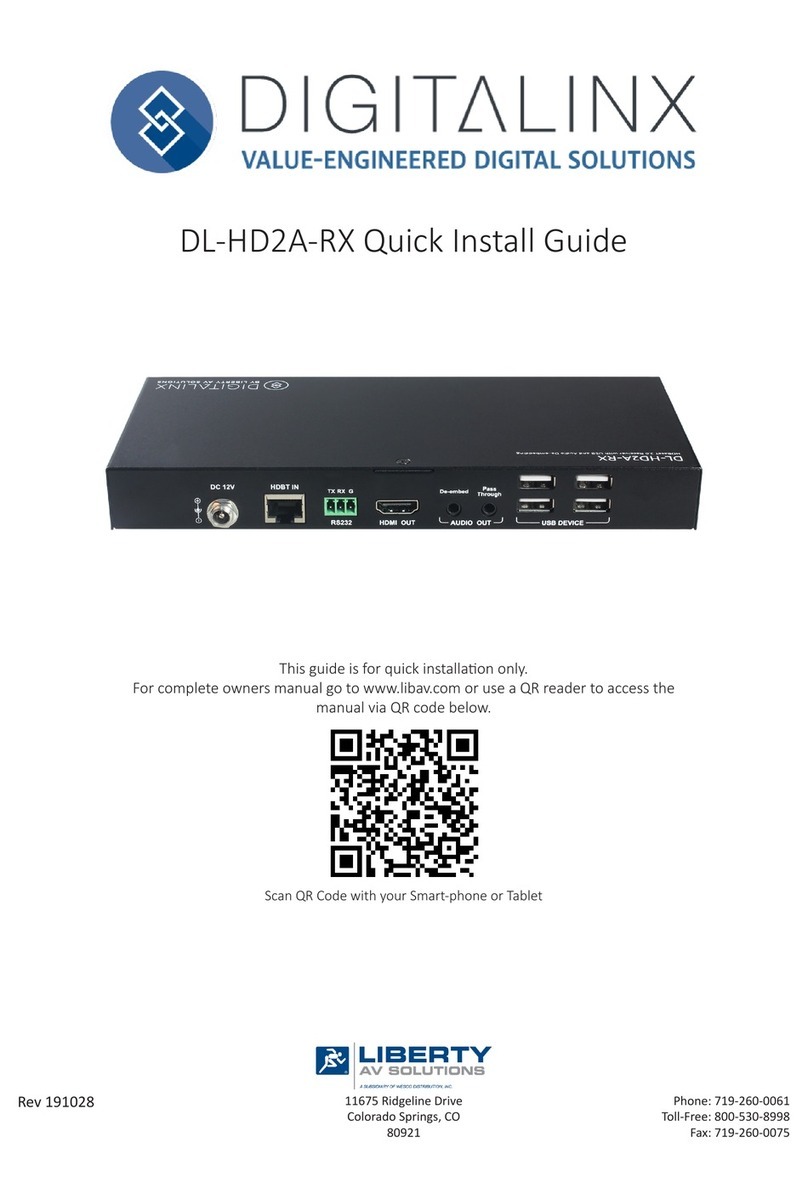
Wesco
Wesco LIBERTY AV SOLUTIONS DIGITALINX DL-HD2A-RX Quick install guide

Cisco
Cisco PowerVu D9850 Quick setup instructions
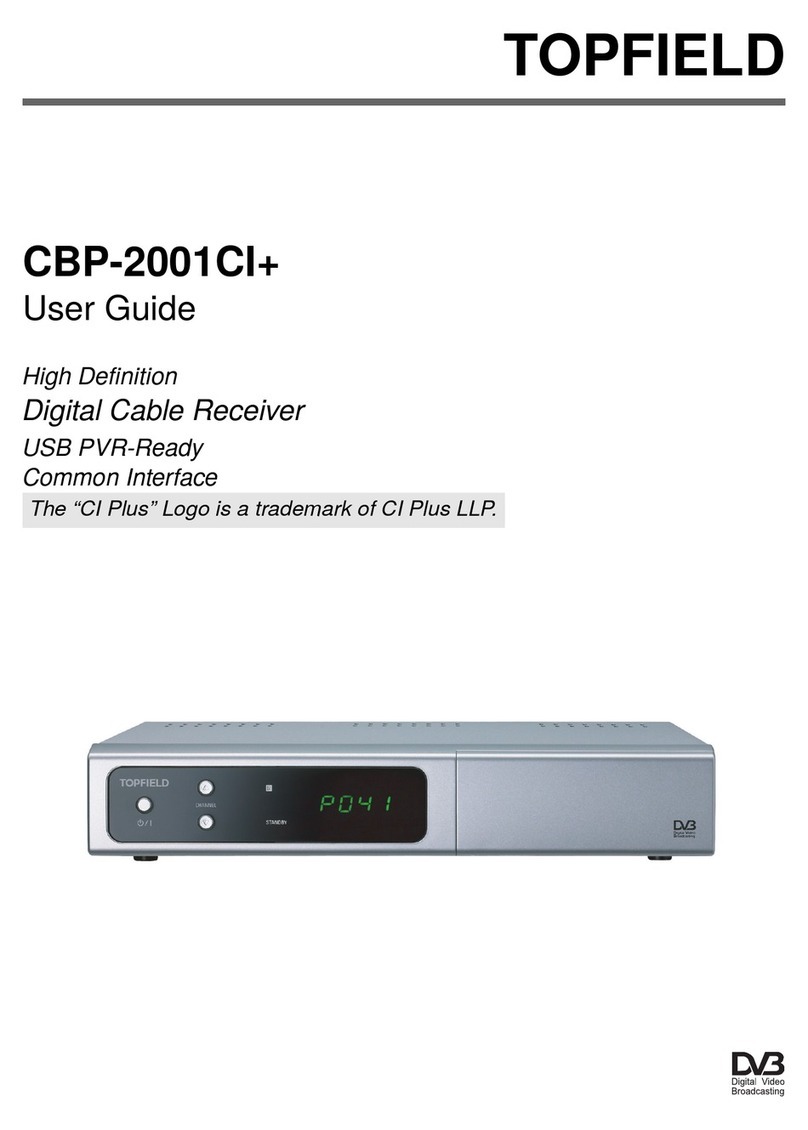
Topfield
Topfield CBP-2001CI+ user guide
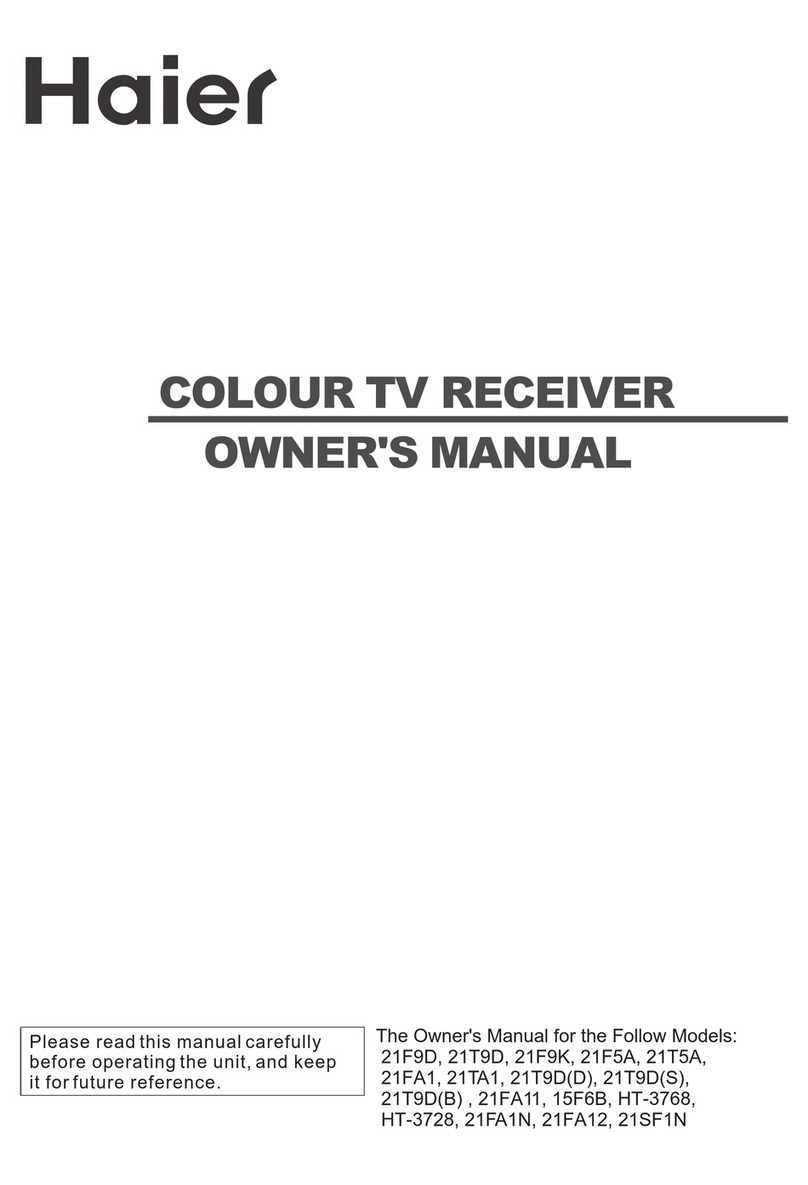
Haier
Haier 21FA18-T owner's manual

Garod Radio
Garod Radio 900 Series Service manual

Yuksel Elektroteknik
Yuksel Elektroteknik MINIX HD PUNTO PLUS user manual



